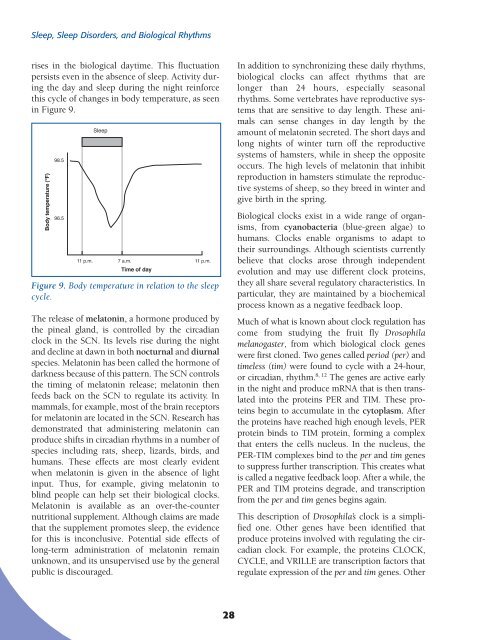Biological - NIH Office of Science Education - National Institutes of ...
Biological - NIH Office of Science Education - National Institutes of ...
Biological - NIH Office of Science Education - National Institutes of ...
You also want an ePaper? Increase the reach of your titles
YUMPU automatically turns print PDFs into web optimized ePapers that Google loves.
Sleep, Sleep Disorders, and <strong>Biological</strong> Rhythms<br />
rises in the biological daytime. This fluctuation<br />
persists even in the absence <strong>of</strong> sleep. Activity during<br />
the day and sleep during the night reinforce<br />
this cycle <strong>of</strong> changes in body temperature, as seen<br />
in Figure 9.<br />
Figure 9. Body temperature in relation to the sleep<br />
cycle.<br />
The release <strong>of</strong> melatonin, a hormone produced by<br />
the pineal gland, is controlled by the circadian<br />
clock in the SCN. Its levels rise during the night<br />
and decline at dawn in both nocturnal and diurnal<br />
species. Melatonin has been called the hormone <strong>of</strong><br />
darkness because <strong>of</strong> this pattern. The SCN controls<br />
the timing <strong>of</strong> melatonin release; melatonin then<br />
feeds back on the SCN to regulate its activity. In<br />
mammals, for example, most <strong>of</strong> the brain receptors<br />
for melatonin are located in the SCN. Research has<br />
demonstrated that administering melatonin can<br />
produce shifts in circadian rhythms in a number <strong>of</strong><br />
species including rats, sheep, lizards, birds, and<br />
humans. These effects are most clearly evident<br />
when melatonin is given in the absence <strong>of</strong> light<br />
input. Thus, for example, giving melatonin to<br />
blind people can help set their biological clocks.<br />
Melatonin is available as an over-the-counter<br />
nutritional supplement. Although claims are made<br />
that the supplement promotes sleep, the evidence<br />
for this is inconclusive. Potential side effects <strong>of</strong><br />
long-term administration <strong>of</strong> melatonin remain<br />
unknown, and its unsupervised use by the general<br />
public is discouraged.<br />
In addition to synchronizing these daily rhythms,<br />
biological clocks can affect rhythms that are<br />
longer than 24 hours, especially seasonal<br />
rhythms. Some vertebrates have reproductive systems<br />
that are sensitive to day length. These animals<br />
can sense changes in day length by the<br />
amount <strong>of</strong> melatonin secreted. The short days and<br />
long nights <strong>of</strong> winter turn <strong>of</strong>f the reproductive<br />
systems <strong>of</strong> hamsters, while in sheep the opposite<br />
occurs. The high levels <strong>of</strong> melatonin that inhibit<br />
reproduction in hamsters stimulate the reproductive<br />
systems <strong>of</strong> sheep, so they breed in winter and<br />
give birth in the spring.<br />
<strong>Biological</strong> clocks exist in a wide range <strong>of</strong> organisms,<br />
from cyanobacteria (blue-green algae) to<br />
humans. Clocks enable organisms to adapt to<br />
their surroundings. Although scientists currently<br />
believe that clocks arose through independent<br />
evolution and may use different clock proteins,<br />
they all share several regulatory characteristics. In<br />
particular, they are maintained by a biochemical<br />
process known as a negative feedback loop.<br />
Much <strong>of</strong> what is known about clock regulation has<br />
come from studying the fruit fly Drosophila<br />
melanogaster, from which biological clock genes<br />
were first cloned. Two genes called period (per) and<br />
timeless (tim) were found to cycle with a 24-hour,<br />
or circadian, rhythm. 8, 12 The genes are active early<br />
in the night and produce mRNA that is then translated<br />
into the proteins PER and TIM. These proteins<br />
begin to accumulate in the cytoplasm. After<br />
the proteins have reached high enough levels, PER<br />
protein binds to TIM protein, forming a complex<br />
that enters the cell’s nucleus. In the nucleus, the<br />
PER-TIM complexes bind to the per and tim genes<br />
to suppress further transcription. This creates what<br />
is called a negative feedback loop. After a while, the<br />
PER and TIM proteins degrade, and transcription<br />
from the per and tim genes begins again.<br />
This description <strong>of</strong> Drosophila’s clock is a simplified<br />
one. Other genes have been identified that<br />
produce proteins involved with regulating the circadian<br />
clock. For example, the proteins CLOCK,<br />
CYCLE, and VRILLE are transcription factors that<br />
regulate expression <strong>of</strong> the per and tim genes. Other<br />
28

















